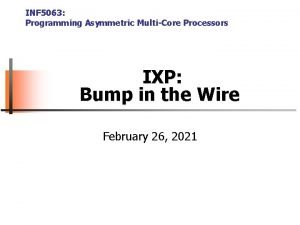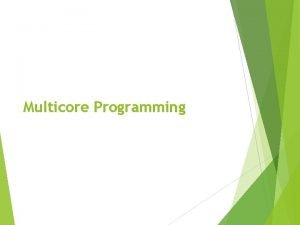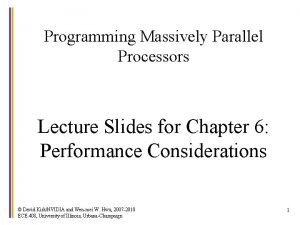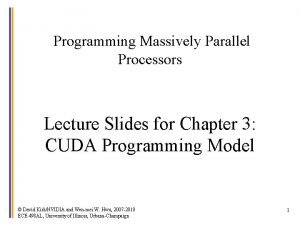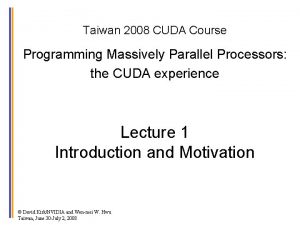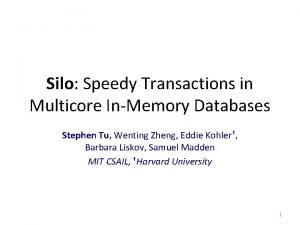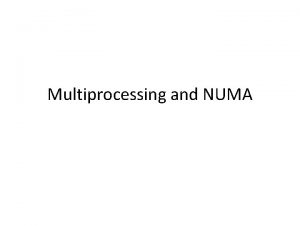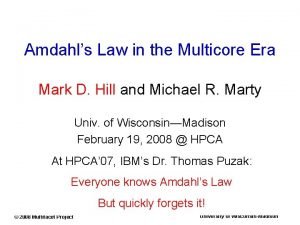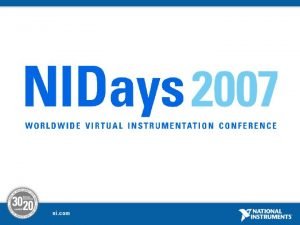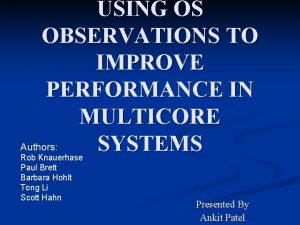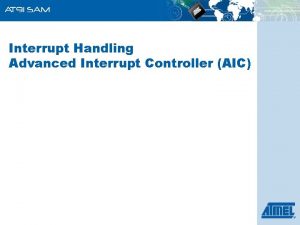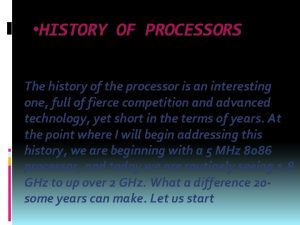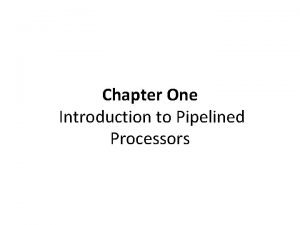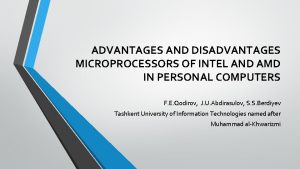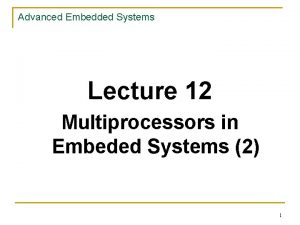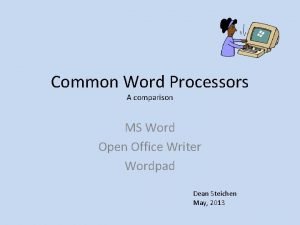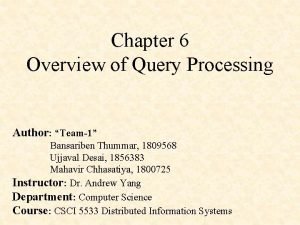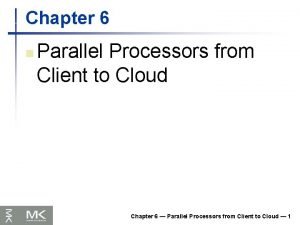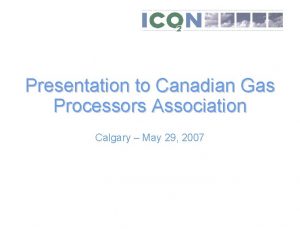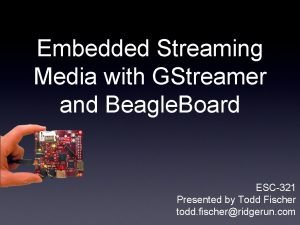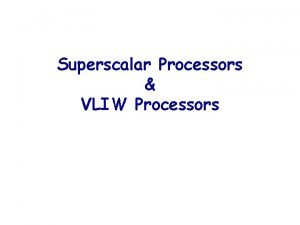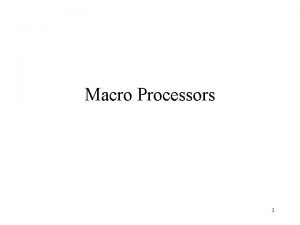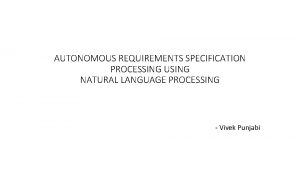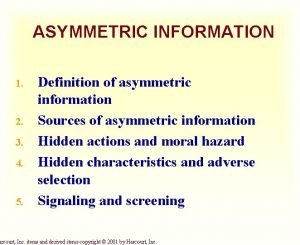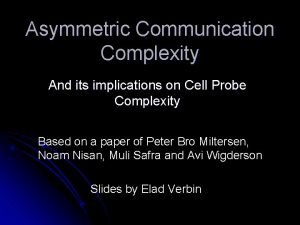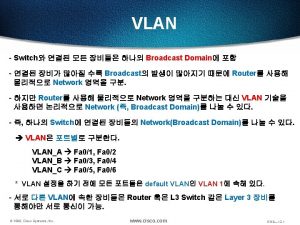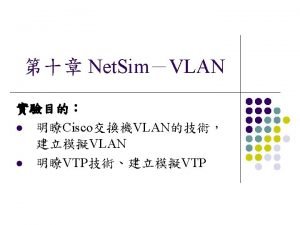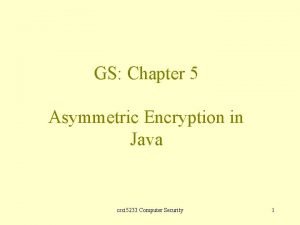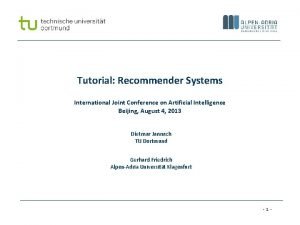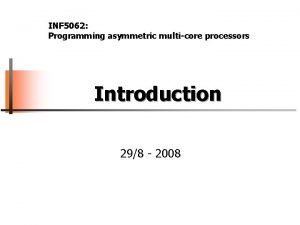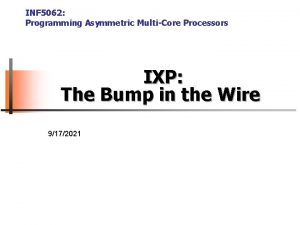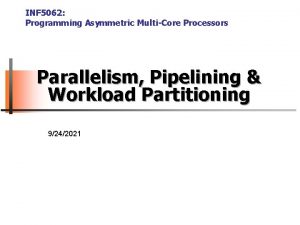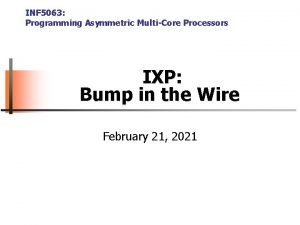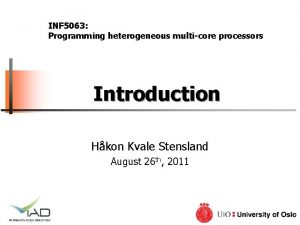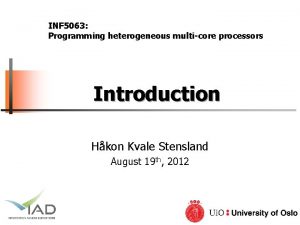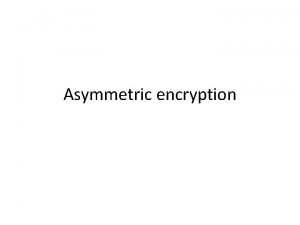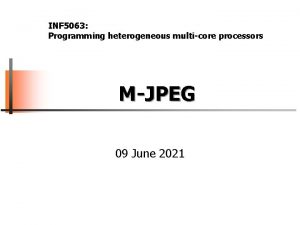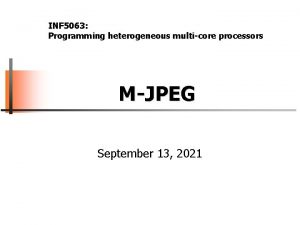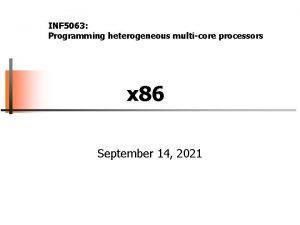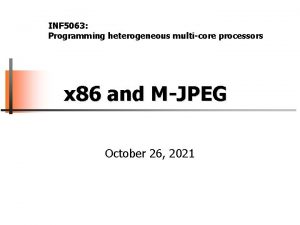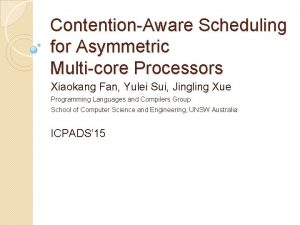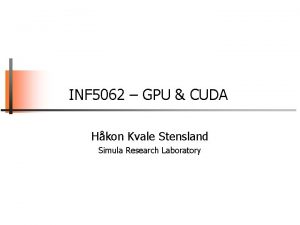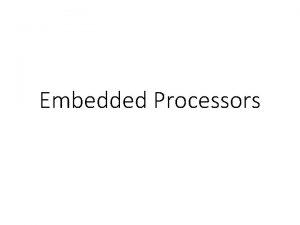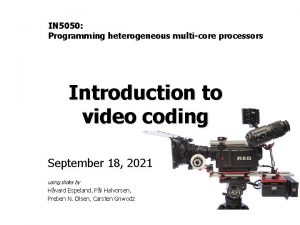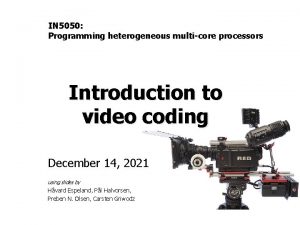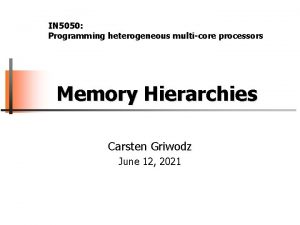INF 5062 Programming asymmetric multicore processors Introduction 19























































- Slides: 55

INF 5062: Programming asymmetric multi-core processors Introduction 1/9 - 2006

Overview ü Course topic and scope ü Examples of asymmetric processors ü (Very) short intro of the Intel IXP 2400 network processors INF 5062 – programming asymmetric multi-core processors 2006 Carsten Griwodz & Pål Halvorsen

INF 5062: The Course

People ü Morten Pedersen (TA) email: mortp @ ifi ü Carsten Griwodz email: griff @ ifi ü Pål Halvorsen email: paalh @ ifi INF 5062 – programming asymmetric multi-core processors 2006 Carsten Griwodz & Pål Halvorsen

About INF 5062: Topic & Scope ü Content: The course gives … Ø … an overview of asymmetric multi-core processors in general and network processor cards in particular (architectures and use) Ø … an introduction of how to program the Intel IXP 2400 network processors Ø … some ideas of how to use/program asymmetric multicore processors (guest lectures and paper presentations) INF 5062 – programming asymmetric multi-core processors 2006 Carsten Griwodz & Pål Halvorsen

About INF 5062: Topic & Scope ü Lab-assignments: An important part of the course are lab-assignments where the students should make a program for the Intel IXP 2400 network processor 1. protocol statistics – download and run wwpingbump and then extend it to give processor, interface and protocol statistics 2. packet bridge with ARP support – forward packet to correct interface (of 3 available) 3. transparent load balancer – balance load and forward packets to the right machine in a cluster of two with same IP address 4. HTTP protocol translator – add support in the transparent load balancer for HTTP streaming having an RTSP/RTP server INF 5062 – programming asymmetric multi-core processors 2006 Carsten Griwodz & Pål Halvorsen

About INF 5062: Exam ü Prerequisite – mandatory assignments: Ø Ø ü lab assignment 1: protocol statistics presentation of a relevant paper Graded assignments (counting 33% each): Ø lab assignment 3: transparent load balancer n n Ø lab assignment 4: HTTP protocol translator n n ü deliver code short demo/explanation of code deliver code and a short report present and demonstrate Final oral exam (counting 33%): early December 2006 Ø Ø excerpts IXP documentation lecture slides presented papers content of lab assignments INF 5062 – programming asymmetric multi-core processors 2006 Carsten Griwodz & Pål Halvorsen

Available Resources ü Resources will be placed at Ø http: //www. ifi. uio. no/~{paalh | griff}/INF 5062 Login: inf 5062 Password: ixp Ø Manuals, papers, code example, … Ø Ø INF 5062 – programming asymmetric multi-core processors 2006 Carsten Griwodz & Pål Halvorsen

Background and Motivation 1: Graphics Processing Units

Graphics Processing Units (GPUs) GPU: buss connector a dedicated graphics rendering device & memory hub 3 D 2 D First GPUs, New powerful GPUs, e. g. , : ü 80 s: for early 2 D operations ü Amiga Nvidia and Ge. Force Atari 7950 used GX 2 a blitter ü dual 400 MHz core – bit block transfer (to offload eachgraphics with 512 MB memory transfers) and Amiga also had the 77 copper ü memory BW: GBps graphics processor ü fill rate: 24 x 109 pixels/s ü 90 s: 3 Dfrom hardware ü similar other for game consoles like PS…and N 64 manufacturers INF 5062 – programming asymmetric multi-core processors 2006 Carsten Griwodz & Pål Halvorsen

General Purpose Computing on GPU ü The Ø high arithmetic precision Ø extreme parallel nature Ø optimized, special-purpose instructions Ø available resources Ø … … of the GPU allows for general, non-graphics related operations to be performed on the GPU ü BUT: how should it be programmed and which tasks should go where? INF 5062 – programming asymmetric multi-core processors 2006 Carsten Griwodz & Pål Halvorsen

Background and Motivation 2: Moore’s Law for single cores

Motivation: Intel View ü Soon >billion transistors integrated INF 5062 – programming asymmetric multi-core processors 2006 Carsten Griwodz & Pål Halvorsen

Motivation: Intel View ü Soon >billion transistors integrated ü Clock frequency can still increase INF 5062 – programming asymmetric multi-core processors 2006 Carsten Griwodz & Pål Halvorsen

Motivation: Intel View ü Soon >billion transistors integrated ü Clock frequency can still increase ü Future applications will demand TIPS INF 5062 – programming asymmetric multi-core processors 2006 Carsten Griwodz & Pål Halvorsen

Motivation: Intel View ü Soon >billion transistors integrated ü Clock frequency can still increase ü Future applications will demand TIPS ü Power? Heat? INF 5062 – programming asymmetric multi-core processors 2006 Carsten Griwodz & Pål Halvorsen

Motivation “Future applications will demand TIPS” “Think platform beyond a single processor” “Exploit concurrency at multiple levels” “Power will be the limiter due to complexity and leakage” Distributed workload on multiple cores + simple processors consume less energy asymmetric multi-core processors INF 5062 – programming asymmetric multi-core processors 2006 Carsten Griwodz & Pål Halvorsen

Co-Processors ü Commodore Amiga was one of the earlier machines that used multiple processors Ø Ø blitter & copper (as we saw for the GPUs) Motorola 680 x 0 IBM power old Motorola kept for backwards compatibility and parts of the OS not ported ü The original IBM PC included a socket for an Intel 8087 floating point co-processor (FPU) 50 -fold speed up of floating point operations ü Intel kept the co-processor up to i 486, where the i 487 actually was a full 486 DX knocking the 486 SX to sleep. INF 5062 – programming asymmetric multi-core processors 2006 Carsten Griwodz & Pål Halvorsen

Intel Multi-Core Processors ü Single-die multi-processors is the new era and the next logical step in driving Moore’s Law into another decade Highly parallel INF 5062 – programming asymmetric multi-core processors Moderately parallel Sequential 2006 Carsten Griwodz & Pål Halvorsen

Intel Multi-Core Processors ü The operating systems can handle only a limited number of threads, e. g. , 64 in Windows (2005) ü Where does the doubling stop? How many applications need more than 64 threads? Performance? software limits is the issue ü Application specific engines? Intel Academic Forum 2006: YES But: Programming model? ? ? INF 5062 – programming asymmetric multi-core processors 2006 Carsten Griwodz & Pål Halvorsen

STI (Sony, Toshiba, IBM) Cell ü Cell is a 9 -core processor Ø combining a light-weight generalpurpose processor with multiple co-processors into a coordinated whole Ø Power Processing Element (PPE) n n n conventional Power processor not supposed to perform all operations itself, acting like a controller running conventional OSes 16 KB instruction/data level 1 cache 512 KB level 2 cache INF 5062 – programming asymmetric multi-core processors 2006 Carsten Griwodz & Pål Halvorsen

STI (Sony, Toshiba, IBM) Cell Ø Synergistic Processing Elements (SPE) n n Ø specialized co-processors for specific types of code, i. e. , very high performance vector processors local stores can do general purpose operations the PPE can start, stop, interrupt and schedule processes running on an SPE Element Interconnect Bus (EIB) n n internal communication bus connects on-chip system elements: o o o n PPE & SPEs the memory controller (MIC) two off-chip I/O interfaces 25. 6 GBps each way INF 5062 – programming asymmetric multi-core processors 2006 Carsten Griwodz & Pål Halvorsen

STI (Sony, Toshiba, IBM) Cell Ø memory controller n n Ø Rambus XDRAM interface to Rambus XDR memory dual channels at 12. 8 GBps 25. 6 GBps I/O controller n Rambus Flex. IO interface which can be clocked independently n dual configurable channels n maximum ~ 76. 8 GBps INF 5062 – programming asymmetric multi-core processors 2006 Carsten Griwodz & Pål Halvorsen

STI (Sony, Toshiba, IBM) Cell Ø Cell has in essence traded running everything at moderate speed for the ability to run certain types of code at high speed Ø used for example in n Sony Play. Station 3: o o o n Toshiba home cinema: o n 3. 2 GHz clock 7 SPEs for general operations 1 SPE for security for the OS decoding of 48 HDTV MPEG streams dozens of thumbnail videos simultaneously on screen IBM blade centers: o o 3. 2 GHz clock Linux ≥ 2. 6. 11 INF 5062 – programming asymmetric multi-core processors 2006 Carsten Griwodz & Pål Halvorsen

Background and Motivation 3: Network traffic increase

Software-Based Network System ü Uses conventional, shared hardware (e. g. , a PC) ü Software Ø runs the entire system Ø allocates memory Ø controls I/O devices Ø performs all protocol processing ü First generation network systems: INF 5062 – programming asymmetric multi-core processors 2006 Carsten Griwodz & Pål Halvorsen

Co py ing Ch ec ks u mm Fr ag i ng me nt a In t i on ter ru pt s Review of General Data Path on Conventional Computer Hardware Architectures sending: application receiving: forwarding: application communication system user space kernel space transport (TCP/UDP) communication network (IP) system link INF 5062 – programming asymmetric multi-core processors 2006 Carsten Griwodz & Pål Halvorsen

Question: ü Which is growing faster? Ø network bandwidth Ø processing power ü Note: if network bandwidth is growing faster Ø CPU may be the bottleneck Ø need special-purpose hardware Ø conventional hardware will become irrelevant ü Note: if processing power is growing faster Ø no problems with processing Ø network/busses will be bottlenecks INF 5062 – programming asymmetric multi-core processors 2006 Carsten Griwodz & Pål Halvorsen

Growth Of Technologies Mbps Engineering rule: 1 GHz general purpose CPU = 1 Gbps network data rate Thus, software running on a general-purpose processor is insufficient to handle high-speed networks because the aggregate packet rate exceeds the capabilities of the CPU year INF 5062 – programming asymmetric multi-core processors 2006 Carsten Griwodz & Pål Halvorsen

Network Processors: The Idea in a Nutshell ü Many designs through many generations (varying amount of HW & SW) ü Include support for protocol processing and I/O on one chip Ø General-purpose processor(s) for control tasks Ø Special-purpose processor(s) for packet processing and table lookup Ø Include functional units for tasks such as checksum computation, hashing, … ð Call the result a network processor ü We are here – they exist ð BUT: programming model? ? INF 5062 – programming asymmetric multi-core processors 2006 Carsten Griwodz & Pål Halvorsen

Network Processors: Main Idea Traditional system: - slow - resource demanding - shared with other operations Network processors: - a computer within the computer - special, programmable hardware - offloads host resources INF 5062 – programming asymmetric multi-core processors 2006 Carsten Griwodz & Pål Halvorsen

Explosion of Commercial Products ü 1990 2000: network processors transformed from interesting curiosity to mainstream product Ø reduction in both overall costs and time to market Ø 2002: over 30 vendors with a vide range of architectures Ø e. g. , n n n n n Multi-Chip Pipeline (Agere) Augmented RISC Processor (Alchemy) Embedded Processor Plus Coprocessors (Applied Micro Circuit Corporation) Pipeline of Homogeneous Processors (Cisco) Pipeline of Heterogeneous Processors (EZchip) Configurable Instruction Set Processors (Cognigine) Extensive And Diverse Processors (IBM) Flexible RISC Plus Coprocessors (Motorola) Internet Exchange Processor (Intel) … INF 5062 – programming asymmetric multi-core processors 2006 Carsten Griwodz & Pål Halvorsen

Agere Payload. Plus: Payload. Plus A Short Overview

Agere Payload. Plus (APP) ü Agere Payload. Plus (APP) Ø consists of both programmable hardware and software Ø consists of both data and control planes (i. e. , slow and fast plane) ü APP defines HW architectures, SW mechanisms, interconnection mechanisms and interfaces, BUT does not specify how to implement them ü Several versions of APP exist differing in the number and types of functional units, degree of parallelism and internal bandwidth (2. generation: 5 models) INF 5062 – programming asymmetric multi-core processors 2006 Carsten Griwodz & Pål Halvorsen

APP Conceptual Pipeline ü State engine Ø Ø ü Classifier Ø Ø Ø extract packets from ingress classify packet send statistics to state engine reassemble blocks pass packet to forwarder together with classification decision INF 5062 – programming asymmetric multi-core processors ü initiate, configure and control classifier and traffic manager receives control from classifier update statistics (e. g. , packet count) check packets against profiles (and inform classifier) Forwarder Ø Ø get packet from classifier perform traffic shaping and management fragment packet (if necessary) modify headers (if necessary) 2006 Carsten Griwodz & Pål Halvorsen

APP 550 Chip INF 5062 – programming asymmetric multi-core processors 2006 Carsten Griwodz & Pål Halvorsen

APP 550 Chip Memory interfaces: - two types of physical memory - fast cycle RAM (FCRAM) for fast memory accesses - double data rate SRAM (DDR-SRAM) for high throughput - the different memory types are usually used like this: INF 5062 – programming asymmetric multi-core processors 2006 Carsten Griwodz & Pål Halvorsen

APP 550 Chip Media interfaces: - several to form fast data paths - two external connections: - cell-oriented (ATM) - packet-oriented (Ethernet) INF 5062 – programming asymmetric multi-core processors 2006 Carsten Griwodz & Pål Halvorsen

APP 550 Chip Scheduling interfaces: - an external scheduling interface - external logic can use information about queues PCI bus interfaces: - allows communication with host CPU - mainly to control the whole operation INF 5062 – programming asymmetric multi-core processors 2006 Carsten Griwodz & Pål Halvorsen

APP 550 Chip Coprocessor interfaces: - APP 550 should be able to process a packet - BUT, to accommodate special cases, e. g. , adding additional headers a co-processor interface is provided INF 5062 – programming asymmetric multi-core processors 2006 Carsten Griwodz & Pål Halvorsen

APP 550 Chip INF 5062 – programming asymmetric multi-core processors 2006 Carsten Griwodz & Pål Halvorsen

APP 550 Chip Stream Editor (SED) - two parallel engines - modify outgoing packets (e. g. , checksum, TTL, …) - configurable, but not programmable Packet (protocol data unit) assembler - collect all blocks of a frame - not programmable Pattern Processing Engine - patterns specified by programmer - programmable using a special high-level language - only pattern matching instructions - parallelism by hardware using multiple copies and several sets of variables - access to different memories Reorder Buffer Manager - transfers data between classifier and traffic manager - ensure packet order due to parallelism and variable processing time in the pattern processing Traffic Manager - schedule packets and shape traffic flow - programmable via scripts - sends packets to output interface - according to implemented policy: - discard packets - choose queue State Engine - gather information (statistics) for scheduling - verify flow within bounds - provide an interface to the host - configure and control other functional units INF 5062 – programming asymmetric multi-core processors 2006 Carsten Griwodz & Pål Halvorsen

APP 550 Full Duplex ü Clock rate for APP 550 is 233 MHz ü One chip cannot manage packet at wire speed in both directions – often two in parallel (one each direction) Ø Ø overhead: all features needed in both direction? classification only one direction checks outgoing packets and enqueues using special queue INF 5062 – programming asymmetric multi-core processors 2006 Carsten Griwodz & Pål Halvorsen

Intel IXP 1200 / 2400: 2400 A Short Overview

IXA: Internet Exchange Architecture ü IXA is a broad term to describe the Intel network architecture (HW & SW, control- & data plane) ü IXP 1200 basic features Ø Ø Ø ü IXP: Internet Exchange Processor Ø processor that implements IXA Ø IXP 1200 is the first IXP chip (4 versions) Ø IXP 2 xxx has now replaced the first version Ø Ø Ø ü IXP 2400 basic features Ø Ø INF 5062 – programming asymmetric multi-core processors 1 embedded 232 MHz Strong. ARM 6 packet 232 MHz µengines onboard memory 4 x 100 Mbps Ethernet ports multiple, independent busses low-speed serial interfaces for external memory and I/O busses … 1 embedded 600 MHz XScale 8 packet 600 MHz µengines 3 x 1 Gbps Ethernet ports … 2006 Carsten Griwodz & Pål Halvorsen

IXP 1200 Architecture SRAM bus: - shared bus (several external units) - usually control rather than data - rate 3. 71 Gbps PCI bus: - allow IXP to connect to I/O devices - enable use of host CPU - rate 2. 2 Gbps Serial line: - connects to the RISC - intended for control and management - rate 38 Kbps SDRAM bus: - provide access to external SDRAM memory used to store packets - can also pass addresses, control/store operations, etc. - rate 7. 42 Gbps INF 5062 – programming asymmetric multi-core processors IX (Intel e. Xchange) bus: - enable higher rates compared to PCI - form fast path (IXP and high-speed interfaces) - interface to other IXP cards - 4. 4 Gbps 2006 Carsten Griwodz & Pål Halvorsen

IXP 1200 Architecture RISC processor: - Strong. ARM running Linux - control, higher layer protocols and exceptions - 232 MHz Access units: - coordinate access to external units Scratchpad: - on-chip memory - used for IPC and synchronization Microengines: - low-level devices with limited set of instructions - transfers between memory devices - packet processing - 232 MHz INF 5062 – programming asymmetric multi-core processors 2006 Carsten Griwodz & Pål Halvorsen

IXP 1200 Processor Hierarchy General-Purpose Processor: - used for control and management - running general applications I/O processors (microengines): - transfers between memory devices - packet processing RISC processor: - chip configuration interface (serial line) - control, higher layer protocols and exceptions Coprocessors: - real-time clock and timers - IX bus controller - hashing unit -. . . INF 5062 – programming asymmetric multi-core processors Physical interface processors: - implement layer 1 & 2 processing 2006 Carsten Griwodz & Pål Halvorsen

IXP 1200 Memory Hierarchy INF 5062 – programming asymmetric multi-core processors 2006 Carsten Griwodz & Pål Halvorsen

IXP 1200 Memory Hierarchy Different memory types… ü…are organized into different addressable data units (words or longwords) ü…have different access times ü…connected to different busses Therefore, to achieve optimal performance, programmers must understand the organization and allocate items from the appropriate type INF 5062 – programming asymmetric multi-core processors 2006 Carsten Griwodz & Pål Halvorsen

IXP 1200 IXP 2400 IXP 1200 PCI bus SRAM access SRAM FLASH SCRATCH memory MEMORY MAPPED I/O PCI access multiple independent internal buses Embedded RISK CPU (Strong. ARM) microengine 1 microengine 2 microengine 3 microengine 4 microengine 5 SDRAM access DRAM IX access microengine 6 DRAM bus IX bus INF 5062 – programming asymmetric multi-core processors 2006 Carsten Griwodz & Pål Halvorsen

IXP 2400 Architecture Coprocessors - hash unit - 4 timers SRAM - general purpose I/O pins bus - external JTAG connections (in-circuit tests) - several bulk cyphers (IXP 2850 only) SRAM - checksum (IXP 2850 only) -… PCI bus IXP 2400 RISC processor: - Strong. Arm XScale - 233 MHz 600 MHz SRAM access coprocessor SCRATCH memory Slowport. FLASH - shared inteface to external units - used for Flash. Rom during bootstrap slowport access SDRAM access DRAM PCI access Embedded RISK CPU (XScale) multiple independent internal Mediabuses Switch Fabric microengine 1 microengine 2 microengine 3 microengine 4 - forms fast path for transfers Microengines - interconnect for severalmicroengine IXP 2 xxx -5 6 8 MSF access … - 233 MHz 600 MHz microengine 8 DRAM bus Receive/transmit buses - shared bus separate busses receive bus INF 5062 – programming asymmetric multi-core processors transmit bus 2006 Carsten Griwodz & Pål Halvorsen

IXP 2400 Architecture ü Memory Ø generally more of everything Ø generally larger gap between CPUs and memory access in terms of cycles Ø local memory on each microengine n n n saving temporary results private per packet processor small (2560 bytes) low latency (one cycle) accessed through special registers INF 5062 – programming asymmetric multi-core processors 2006 Carsten Griwodz & Pål Halvorsen

IXP 2400 Basic Packet Processing PCI bus SRAM access SRAM coprocessor SCRATCH memory FLASH slowport access SDRAM access DRAM PCI access multiple independent internal buses Embedded RISK CPU (XScale) microengine 1 microengine 2 microengine 3 microengine 4 microengine 5 MSF access … microengine 8 DRAM bus receive bus INF 5062 – programming asymmetric multi-core processors transmit bus 2006 Carsten Griwodz & Pål Halvorsen

The End: Summary ü Asymmetric multi-core processors are already ð Challenge: programming Ø should know the capabilities of the system Ø identify which parts of a program that should run where Ø different methods to program the different components ü We will use Intel IXP 2400 as an example which offers… Ø …embedded processor plus parallel packet processors Ø …connections to external memories and buses ü Next time: how to start programming these monsters INF 5062 – programming asymmetric multi-core processors 2006 Carsten Griwodz & Pål Halvorsen
 Asymmetric multicore processing
Asymmetric multicore processing Multicore programming
Multicore programming Programming massively parallel processors
Programming massively parallel processors Programming massively parallel processors
Programming massively parallel processors Massively parallel processing ppt
Massively parallel processing ppt Programming massively parallel processors, kirk et al.
Programming massively parallel processors, kirk et al. Speedy transactions in multicore in-memory databases
Speedy transactions in multicore in-memory databases Multicore packet scheduler
Multicore packet scheduler Multiprocessor vs multicore
Multiprocessor vs multicore Amdahl's law in the multicore era
Amdahl's law in the multicore era Cache craftiness for fast multicore key-value storage
Cache craftiness for fast multicore key-value storage Multicore vs multiprocessor
Multicore vs multiprocessor Obs multicore
Obs multicore Autosar multicore
Autosar multicore Difference between linear and nonlinear pipeline processors
Difference between linear and nonlinear pipeline processors Interrupt handling in arm processors
Interrupt handling in arm processors The history of cpu
The history of cpu Unifunction and multifunction pipeline
Unifunction and multifunction pipeline Digital camera processors
Digital camera processors Advantages and disadvantages of amd processors
Advantages and disadvantages of amd processors Embeded processors
Embeded processors Microcontrollers and embedded processors
Microcontrollers and embedded processors Comparison of word processors
Comparison of word processors Characteristics of query processor
Characteristics of query processor Parallel processors from client to cloud
Parallel processors from client to cloud Gas processors association
Gas processors association Beagleboard embedded processors
Beagleboard embedded processors Ece 526
Ece 526 Data structures used in macro processor
Data structures used in macro processor Difference between superscalar and vliw
Difference between superscalar and vliw Macro processors
Macro processors Language and processors for requirement
Language and processors for requirement Networks and telecommunications presentation
Networks and telecommunications presentation Advantages of symmetric key encryption
Advantages of symmetric key encryption Symmetric and asymmetric matrix
Symmetric and asymmetric matrix Introduction to corporate communication
Introduction to corporate communication Asymmetrical and symmetrical iugr
Asymmetrical and symmetrical iugr Asymmetric information game theory
Asymmetric information game theory Asymmetric vlan
Asymmetric vlan Asymmetric information diagram
Asymmetric information diagram Asymmetric information diagram
Asymmetric information diagram Asymmetric communication
Asymmetric communication Vlan4094
Vlan4094 Strategic view of ihrm
Strategic view of ihrm Des aes
Des aes Asymmetric vlan
Asymmetric vlan Asymmetric vlan
Asymmetric vlan The strength of any cryptographic system rests with the
The strength of any cryptographic system rests with the Asymmetric encryption java
Asymmetric encryption java Two way asymmetrical model example
Two way asymmetrical model example Projection bias
Projection bias Verapamil depression side effects
Verapamil depression side effects Asymmetric parabola
Asymmetric parabola Asymmetric key cryptography
Asymmetric key cryptography Asymmetric synthesis example
Asymmetric synthesis example Asymmetric dominance effect
Asymmetric dominance effect
